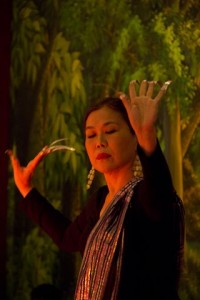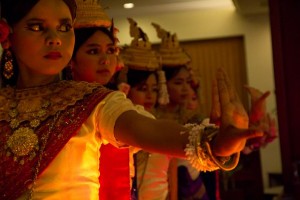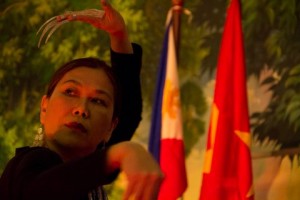By Nannette Matilac
Photos by Leonard Reyes, NTFP

To dance pangalay among ASEAN compatriots is a privileged experience, especially because fellow nationals from Asian countries appreciate this dance tradition that is akin to their own.
I was lucky to be in Siem Reap in October 2012 as the official documenter of the “First Regional Policy Workshop on Community Carbon Pools for Reduced Emissions from Deforestation and Forest Degradation Plus Enhancing Forest Carbon Stocks (REDD+).”
The conference gave me the opportunity to dance pangalay for cultural exhange and friendship during the closing dinner event on 25 October 2012 at the Angkor Paradise Hotel inSiem Reap,Cambodia.
Home to the architectural marvels of Angkor Wat, Ta Phrom, Bayon, Banteay Srei and other beautiful temples, the experience of dancing pangalay in Siem Reap side by side with the Robam boran performed by Khmer dancers, is a gift.
The rationale of the conference–to reduce carbon dioxide emissions being released to the atmosphere of our planet that is now causing climate change—is an incredible task. The two-day meeting was convoluted with presentations, workshops, panel discussions and planning activities from morning to early evening.
Documenting the proceedings was exhausting and confusing especially with the quaint inflections, enunciations and pronunciations of fellow Southeast Asians. Imagine dealing with technical terms and acronyms–GHG, LUCLUF, CCP, CF, REDD+, UN FCCC and so on–along with struggle to decipher the words and meanings being articulated by the delegates. (For instance, “carbon rights”, the byword in the conference, was pronounced in peculiar ways indiscernible to my ears.)
Therefore, to be able to dance after the chores of two long days is a pleasure and a present for me, for the workshop participants, for Cambodia, for Asia and the world. It is also an opportunity to thank heaven for bringing me at the right place to dance the pangalay. After all, our ancestors danced to be able to affect climate and the seasons. Maybe I was dancing with them to help appease Mother Nature and influence climate change.
And, of course, there is the image of Shiva who dances to express vitality in the universe, maintaining harmony, symbolizing the twin opposites of life and death, of creation and destruction. It is perhaps Shiva’s cosmic dance that influenced the dancing of the devatas and apsaras magnificently sculpted on theAngkor temples in Siem Reap. I suppose it is not by accident that the conference was held in the ancient capital of the Khmer civilization. Many of the bas reliefs on the stone walls beckon the story of the universe, the self-same story that is perhaps the bottomline underlying the jargon on reducing carbon dioxide emissions and climate change, which is the dualism in nature as expressed by the cosmic dance of Shiva.
As for pangalay, I have re-affirmed the original theory of my teacher Ligaya Fernando-Amilbangsa that pangalay is the “Philippine dance style closest to a classical form”, and the “living link to the dance cultures in Asia such as the Indian, Thai, Balinese, Javanese and Cambodian styles of classical dancing”. I was told that the young dancers and the musicians who performed the Robam boran were smiling and nodding in appreciation as I danced the pangalay. Maybe they felt the affinity in their souls. In the corner of my eye, I saw some were busy recording the pangalay dance with their cellphones.

The Asians and Europeans among the audience articulated the similarity between the postures and gestures of the Khmer classical dance and the pangalay.
Ironically, the Filipinos in the audience were clueless that pangalay is a Filipino dance style—not Thai or Khmer but truly Filipino. This brings to mind how deep the effect of colonial acculturation is on us, and how important it is to promote this precious intangible cultural heritage among the Filipino people.

Finally, dancing pangalay in Siem Reap have led me to deepen my understanding of the need to dance and breathe in harmony with nature to mitigate if not stop the devastating effects of climate change.



Mabuhay Ate Nanette! Mabuhay Pangalay! 🙂
You are at the core of 2 vital issues – climate change for the survival of humankind & the promotion of our beautiful & precious “pangalay”– you can’t be more pertinent!….Congratulations, we’re so proud of you!